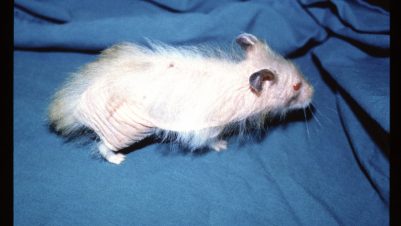There are three species of hookworm that are of significance in Europe. These are Ancylostoma caninum, Ancylostoma tubaeforme and Uncinaria stenocephala. In the UK, Uncinaria stenocephala, also known as the northern hookworm, is the most common, and is consistently found at a low prevalence in dogs. This is surprising as the opposite is true in foxes, where there is a much higher prevalence. Wright and Wolfe (2007) found a prevalence in domestic dogs in a region of northern England of 3.75 percent. A higher prevalence may be seen in breeding, racing and hunt dogs, particularly those with poor husbandry.
Ancylostoma caninum is only sporadically seen in the UK, and it is considered a parasite of warm climates. The prevalence could increase due to inadequate worm control of dogs that have been in continental Europe and as a result of climate change, but this article focuses on Uncinaria, which is currently more common.
Life cycle of Uncinaria stenocephala
Adult Uncinaria stenocephala worms are small, measuring 10 to 20mm in length, and are located in the final quarter of the small intestine. Blood sucking is minimal with these worms compared to Ancylostoma. The life cycle is direct, with eggs (shown in Figure 1) passed in the faeces developing to third stage larvae (L3) in the environment. When these are ingested, they develop to adult worms in two to three weeks.

L3 larvae can penetrate the skin and cause cutaneous signs, but they do not establish an intestinal infection through this route (although this is possible with Ancylostoma caninum). There is no marked somatic migration and no transfer to pups via milk.
Clinical signs
Intestinal signs are uncommon but diarrhoea is possible with heavy infections. Signs are predominantly cutaneous and are caused by L3 larvae penetrating the pads, interdigital skin and skin in contact sites.
Early lesions are papules with cutaneous erythema. More chronic lesions are swollen and painful pads with intensely erythematous interdigital skin (Figure 2). Hyperkeratosis of the pads with fissures (Figure 3) is often marked in severe chronic cases. Having both interdigital and pad lesions is highly suggestive of hookworm dermatitis. Pedal lesions are possible in people if they walk barefoot on contaminated ground, causing a disease known as “creeping eruption”.
Differential diagnosis
- Demodectic pododermatitis
- Irritant contact dermatitis
- Pelodera dermatitis
- Atopic dermatitis with secondary bacterial or Malassezia infection
- Necrolytic migratory erythema
- Pemphigus foliaceus


Diagnosis
The history is important in making the diagnosis, as most cases of hookworm dermatitis are associated with poor husbandry. The dogs are often housed on dirt runs or grass with others, and there will have been inadequate worm control. Many cases have been reported in greyhounds, although any breed of dog kept in poor conditions could be affected.
In suspected cases, rule out differential diagnoses and perform cytological examination of tape strips, hair
In suspected cases, rule out differential diagnoses and perform cytological examination of tape strips, hair plucks and skin scrapings
plucks and skin scrapings. In severe cases, consider biopsy. Faecal flotation can be used to detect eggs.
Dermatopathology can be undertaken. Biopsy may be useful to rule out demodectic pododermatitis in chronic cases. Otherwise, histological examination is frequently non-specific, with perivascular dermatitis containing eosinophils and neutrophils. Note that larvae are rarely found in tracts. Monitoring the response to treatment can also help in making an accurate diagnosis.
Treatment
Affected dogs and in-contacts should be treated with a product that has a licence for treating Uncinaria. Regular anthelminthic treatment should be instigated based on risk assessments and consideration of an overall parasite control regime.
Disinfection of the environment and daily removal of faeces is essential. Provide dry bedding subsequently. In cases where dirt runs are unavoidable, treatment with sodium borate (0.5kg per square metre) has been suggested (Hnilica and Patterson, 2017). Note, however, that this treatment will kill vegetation.
Prognosis
With regular anthelminthic treatment and attention to good husbandry measures, the prognosis for animals with this condition is good.







-1628179421-401x226.jpg)




